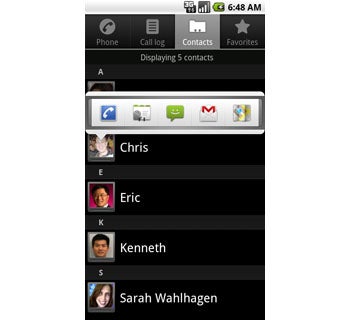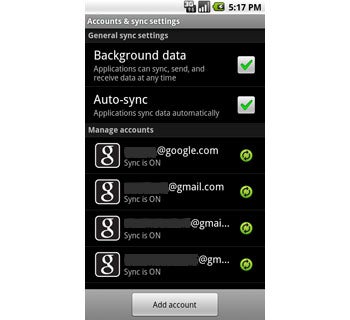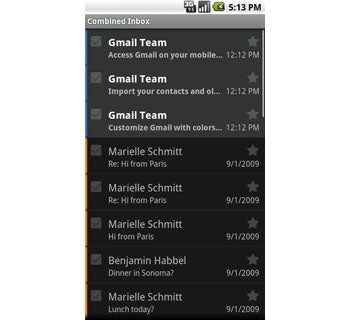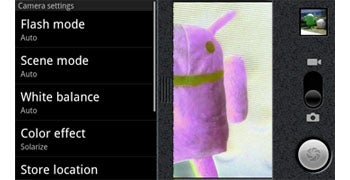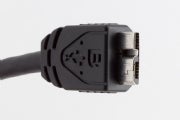When you stroll into your local store to shop for a new TV, dozens of big, glossy screens will greet you, each one trying to draw you in with its bright, colorful pictures. And a bewildering bevy of new features promise a multitude of benefits. Which ones will make a difference in what you watch and in how it looks on the screen? We'll help you sort out what's important. (If you haven't bought an HDTV before, see our previous article package on setting up an HDTV.)
The Changing World of Television
It's official: The (television) world is flat. The market has just about completed the transition from the large, heavy, cube-shaped, standard-definition CRT (picture-tube) television set to the sleek, thin, light, high-definition flat-panel set. According to market research firm DisplaySearch, worldwide shipments of flat-panel televisions shifted from about 5 percent of all sets in early 2004 to nearly 75 percent of the total last spring. In terms of revenue, flat panels now account for more than 90 percent of the worldwide television market. The Consumer Electronics Association says that 52 percent of U.S. households have an HDTV today. And now that the digital transition is complete, HDTV adoption continues apace.
For many shoppers, this year's television purchase may bump a previously purchased HDTV down to some other area of the house, such as the kitchen or a bedroom. But whether this is your first HDTV set or your third, it pays to get a model that's packed with all of the latest features. You'll likely find some eye-popping HDTV deals this holiday season, but don't expect prices to plummet, even if HDTV prices today are 20 percent lower than they were last year. According to DisplaySearch analyst Paul Semenza, the LCD panels used in HDTVs are actually getting more expensive. So far, prices of models on store shelves haven't reflected this shift--but it could inhibit the deep discounts that often appear during a holiday buying season.
Another recent trend is full-resolution HDTVs: All but a few entry-level, low-cost models with screen sizes greater than 40 inches have the 1920-by-1080 resolution of "full HD" (1080p). At smaller screen sizes, 720p remains common: On Best Buy's Web site, I found that 18 of the 35 sets between 30 and 39 inches were 720p, including models from LG, Panasonic, Samsung, and Sony.
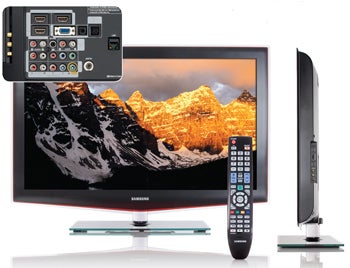
40" Samsung LN40B650T1f: It's the priciest 40-inch model on our Top 5 chart of 40-to-42-inch HDTVs, but this television offers first-rate picture quality, along with a slew of ports for Internet features and other network connections, all while being very usable.
Beyond entry-level sets, today's HDTVs differentiate themselves with features that can enhance your viewing experience and improve the TV's performance. Several capabilities--such as fast-motion response times and LED backlighting--that were once exclusive to super-pricey high-end models are now showing up in more-affordable mainstream units. But what do these new features mean, and will they make a noticeable difference in your viewing? Which features are merely nice to have, and which ones are worth paying extra money to get?
(Note: For this feature overview and our latest roundup of HDTVs, the PC World Labs developed a new, up-to-date suite of tests, described in "How We Test HDTVs.")
Rising Refresh Rates
According to DisplaySearch, about half of all LCD HDTVs with 40-inch or larger screens now have refresh rates of 120Hz or higher. It took a couple of years for 120Hz to reach the mainstream, but today only entry-level and economy models at these large sizes have the standard 60Hz refresh rate. The picture changes for sets under 40 inches, though: DisplaySearch says that among all such LCDs shipped in the second quarter of 2009, only 14 percent were capable of 120Hz. The company expects that figure to grow to 24 percent by the year 2013.
Some manufacturers have made a full-on push to 120Hz. Sony, for example, has only one series--the Bravia S5100--that doesn't have 120Hz or 240Hz models.
Note the emphasis here on LCDs (versus plasma screens): Since LCDs have the lion's share of the flat-panel market at more than 90 percent, it makes sense that they get most of the attention. But LCD technology has a known issue with fast motion, stemming from the fact that it relies on moving tiny molecules around to block or to transmit the light from the panel's backlight. And these molecules need time to move from one position to another. As a result, traditional panel designs ran into a problem with motion blur. Commonly, the leading and trailing edges of a fast-moving object in an image looked soft, an unwelcome artifact--and not just for hockey fans trying to follow a speeding puck on the screen.
Refresh Rates, Continued
Panel manufacturers found that changing the cell structure and the formulations of liquid crystal material wasn't enough to overcome this problem: The trick was to refresh the image twice as often, doubling the refresh rate from 60 to 120 times a second. In addition, manufacturers improved their televisions' controlling circuitry so that it would look at the two original frames in the 60Hz image stream, and interpolate a new frame to provide an intermediate image.
This approach produced a marked improvement over traditional 60Hz sets, one that's well worth the extra investment in a set with a minimum of 120Hz. The price difference has narrowed, but you can still expect to pay approximately $100 to $200 more to step up to an HDTV set with this feature in the 40- to 42-inch range. It's a must-have feature if you plan to watch sports, but any content that includes panning scenes and fast action will benefit from this technology.
If 120Hz is good, then 240Hz must be twice as good, right? The answer is a lot murkier than that. The manufacturers that offer 240Hz refresh technology are divided into two camps, each with a different approach. Samsung and Sony use a true 240Hz technology, in which (as in 120Hz sets) the controller starts with a pair of frames from the 60Hz content stream--but then creates three additional intermediate frames, not one. This means that for each of the original frames, the set actually displays four frames. (The math changes for 24p signals, such as those piped out by Blu-ray Disc players, but the concept is similar.)
Adding these extra frames causes the liquid crystal material to move more quickly than it otherwise would, which in turn reduces the blur effects. The difference may be noticeable compared with 120Hz, but in our tests it wasn't as dramatic as the difference between 60Hz and 120Hz, even when we looked at the sets side by side. As such, 240Hz is probably not worth paying a lot more for over the cost of a 120Hz model. (Right now, the jump from 120Hz to 240Hz is about $300 to $600, a large premium compared with the step from 60Hz to 120Hz.)
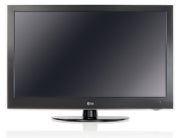
LG 42LH50
LG approaches 240Hz by a different path: Its models with 240Hz performance generate one interpolated frame for each of the standard 60Hz frames, just as 120Hz models do, but they flash their backlights twice for every frame. Thus, 60 original frames plus 60 more interpolated frames make 120 frames, and then the backlight flashing twice for each frame yields 240 flashes per second. Like a strobe light in a disco dance hall, the flash of the backlight helps freeze the action on the screen and reduce motion blur. But this eye trick still presents only 120 frames per second, so asserting that its refresh rate is faster than 120Hz rests on rather shaky science.
Panels with 120Hz (or faster) refresh rates have one additional benefit: Most television programming is recorded at 30 frames per second (fps), which is easy to double for the 60Hz refresh rate that most HDTVs have used. Movies, however, are filmed at 24 fps, which poses problems for technicians seeking to digitize them for DVD or broadcast formats. To fit the 30-fps timing, every four frames of movie film must be stretched to fit five frames of video. The process employed to achieve this, called "3:2 pulldown," uses two interlaced fields of the first film frame and then three interlaced frames of the next frame to produce the stretch.
This awkward conversion can create a motion artifact called "judder," a jerkiness or slight stutter visible in the finished image. But since 120Hz, unlike 60Hz, is an even multiple of 24, these panels can display 24-fps material without requiring any conversion; each frame just gets shown five times.
Note also that plasma does not have this problem. The individual plasma pixels can actually turn on and off much faster than an LCD pixel; in fact, Panasonic has taken to describing their panels as "600 Hz". Plasma needs this extra speed because a pixel can only be on or off, and so must be turned on and off rapidly during each frame of an image to create the correct shade of color. So in theory, motion blur is not a problem for plasma models. However, the PC World Labs' tests showed that, at least in the case of the two plasma models we tested from Panasonic--the TC-PS461 and the TC-P42X1--some plasma sets could learn a thing or two from LCDs.
LED Backlighting
Another feature growing in prominence is the use of LEDs as backlights for LCD TV panels. Both Samsung and Toshiba call their models with this feature "LED TVs," which has confused many consumers. LED TVs are not a new technology; they're just LCD TVs with a different type of backlight. LEDs have some distinct advantages over traditional cold-cathode fluorescent lamp (CCFL) designs, which many LCD TVs use. Compared with CCFL technology, LED backlighting results in TVs that require less power (by up to 40 percent for a 40-inch television) and provide improved color performance: LED TVs handle red and green hues better, resulting in more-natural, more-lifelike picture quality.
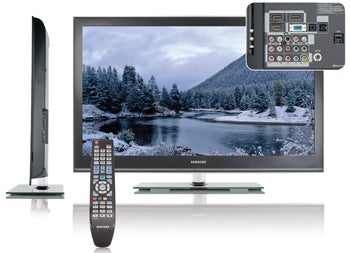
46" Samsung LN46B750U1F: The top-ranked model on our chart of larger high-definition sets, this 46-inch HDTV earned plaudits for superb picture quality, Internet connectivity, and an array of functions on its full-featured remote control.
Perhaps the foremost advantage of LED backlighting is its ability to enhance contrast and produce darker blacks. This capability closes the gap between LCD screens and plasma displays, which traditionally have offered deeper blacks than LCDs. Here again, manufacturers have adopted two different approaches to implementing LED backlights. One design puts the LED lights behind the LCD panel in a big matrix layout. This approach permits the use of "local dimming": If the controller recognizes that a portion of the image is generally dark, it can automatically dim the LEDs behind that one small segment of the image. This helps keep black levels low, increasing the apparent contrast.
The other way to use LEDs with LCD panels is to put them along the edge behind the panel, as Samsung's 1.2-inch-thick, 46-inch UN46B8000 does. This approach requires sophisticated diffusers to spread the light evenly behind the LCD layer, and it reduces or eliminates the ability to improve apparent contrast through localized, content-based dimming. It does keep the part count much lower, however, and it can make the heat that the LEDs generate easier to manage.
Though LEDs have their benefits, they come with their own issues. For one thing, LED TVs cost appreciably more than CCFL-based models--about $300 more, on average--due both to the cost of manufacturing the LEDs and to the cost of installing these arrays. Also, LED production processes cannot yet make units with consistent color output, so manufacturers must inspect each LED and "bin" it--grouping it with other LEDs of similar color. The more consistent and accurate the color output required, the more the individual LEDs cost. Until the industry solves this problem, LCD TVs with LED backlights are likely to cost more than CCFL sets.
If you care about color quality and are willing to tweak your television, an LED-backlight model may be worth the extra money. Even at a $300 premium, you would be paying less than $30 a year extra over the set's expected lifetime, or less than $2.50 a month. We've seen some lovely images produced by LED-backlit HDTVs--on the Samsung LN-A950, for example. Note, however, that none of the models we tested for this roundup included LED backlights.
Connectivity
Another big trend this year involves connections to bring the Internet to your TV. Many HDTVs have an ethernet connection on the back, plus integrated software for dealing with Web content. If you connect to the Internet via your home network's router, your TV can gain access to a range of Web-based content, all without going through a computer.
According to data from Nielsen, 90 percent of U.S. homes now have access to broadband Internet connections, so the connected TV is entirely feasible with today's technology, especially if the HDTV set has a Wi-Fi capability, as many do.
The TVs shipping today that have Web access limit the locations you can visit online. This approach simplifies navigation, which is important because you have to use a remote control instead of a keyboard, mouse, and full-on Web browser.
This year marks the debut of Yahoo Connected TV's Widgets; the Widgets are now offered on Internet-capable sets from LG, Samsung, Sony, and Vizio. The services and presentation vary from one brand to another, as manufacturers make different choices about which Widgets to offer. Widgets are available for news, weather, and sports information, as well as for access to popular sites like YouTube, Twitter, Flickr, and Facebook.
Yahoo Widgets isn't the only Internet connectivity going. Sony has continued to develop its Bravia Internet Video Link version of streaming, Web-based content--which includes modules for Amazon Video on Demand, CBS, Netflix, Slacker Internet Radio, YouTube, and more. Other sets, such as units developed by Panasonic and by LG Electronics, have modules for services as well; the most popular inclusions are Amazon Video on Demand, Netflix and Vudu, along with photo sharing sites such as Flickr and Picasa, and streaming music Websites like Pandora and Slacker Internet Radio.
Network connectivity can give you access to the content you've stored on your home network, including CDs you've ripped, digital photos, and digital home movies. Some sets can access those items, as well. The Digital Living Network Alliance certifies most connected TVs; put your files on a DLNA-certified storage device on your network, and a DLNA television will be able to play your music and screen your photos and videos. According to the Alliance's Website (www.dlna.org) more than 500 DLNA-certified television models are available. Windows Media Player 11 and 12 are DLNA servers too, so using a PC that runs XP, Vista, or Windows 7 will work, if you use WMP 11 or 12 for your media library.
Integrated ethernet has another advantage: Upgrades to your television's software can download automatically, so the updated firmware, or a new Widget or other service, will be available the next time you turn on your HDTV.
Network connectivity will give you access to an enormous amount of additional content--much of it on-demand and free--but do some research before plunking down your cash if you want specific services or capabilities. Having an ethernet connection doesn't automatically mean that an HDTV will stream media through your home network, or have all the Web services you seek.
Going ‘Green'?
Consumer electronics are going green, and the HDTV market is no exception to the trend. While plasma flat panels continue to consume more electricity than LCD models, both technologies have made notable strides in energy conservation.
For example, "eco modes" dim the picture to save energy when the viewer doesn't need full brightness, working in much the same way as a draft mode on a printer. Automatic ambient light sensors can adjust an image's brightness, saving energy. And plasma manufacturers have developed some more-efficient technologies that reduce the power a plasma television consumes.
Most manufacturers are not shy about touting their "greenness," whenever possible. To check for lower power consumption, look for the Energy Star 3.0 logo. To qualify for this optional program, run jointly by the U.S. Environmental Protection Agency and the U.S. Department of Energy, an HDTV must not exceed a specified maximum power consumption limit. This limit differs somewhat depending on the set's screen size, and the Energy Star program breaks out HDTVs into three segments: smaller than 40 inches, 40 inches to 58 inches, and larger than 58 inches. (Click for a list of models that qualify for Energy Star logos.)
The next revision of Energy Star, Version 4.0, is due to take effect on May 1, 2010, and Version 5.0 will replace it on May 1, 2012. These new specifications further reduce the maximum allowable amount of energy that a qualifying set can use.
Other industry groups are promoting their own energy consumption guidelines and logos. The LCD TV Association's "Green TV" initiative currently requires that a TV have an ambient light sensor that will automatically adjust the screen's brightness in response to room lighting conditions; dimming the screen in darkened rooms helps save energy (more stringent guidelines are in the works). So far, only LG Electronics has qualified its televisions--four lines, to be precise--for this logo. Of course, the "Green TV" logo alone doesn't determine whether a TV has this capability: Sony's VE5 series of televisions has an ambient light sensor, too, among other eco-friendly modes.
Meanwhile, the California Energy Commission (CEC) has proposed legislation dictating its own energy consumption limits for televisions. Differing from optional programs like Energy Star and Green TV, the CEC's proposed regulations would be mandatory. Under the CEC's proposal, it would be illegal to sell nonconforming products in the state of California. (Because California is so big, such regulations could afffect sets nationwide, as well.)
The CEC has stated plans to make a final decision about the specifications--which would likely place limits on the maximum operating power consumption for all flat-panel televisions, as well as other modes such as standby--this November. All flat-panel TVs--especially larger plasmas--could be impacted by this legislation; some models meet the requirements, and others do not. Meanwhile, plasma TVs remain, on average, less-expensive than same-size LCD TVs (a 50-inch plasma can be about $300 less than a comparable LCD).
According to some sources, consumers can save $15 to $30 a year on their electricity bills by choosing a set with lower power consumption. This may not seem like a big deal, but consider that the average U.S. consumer keeps a television for ten years or longer. A savings of $150 to $300 on a set that originally cost $500 to $1000 is a significant amount.
Whither OLED?
What about the new, revolutionary flat-panel technologies--such as OLED--that you may have heard of and that are supposed to arrive "any day now"? The answer is that they're not coming any time soon, at least not a way that will have any significant impact at present on your buying decision.
In recent years, we've had an alphabet soup of new technologies, including FED and SED, paraded around at fancy demos. These promising advances have fizzled for many reasons, but perhaps the unrelenting decline in LCD and plasma prices is most to blame for their failure to come to market. A set that was targeted to sell for $2500 a few years ago must now sell for under $1000, wiping out any profit that would have been made at the higher price. As LCD and plasma manufacturers continue to improve production efficiencies and economies of scale, it becomes increasingly difficult for new display technologies to gain a foothold.
Most Promising (Maybe): OLED
The most promising technology that might yet catch on remains organic light-emitting displays (OLEDs). OLEDs are emissive like a picture-tube (CRT) television, which eliminates issues with viewing angles; and the technology is fast and highly responsive, so it lacks motion blurring. OLED displays are incredibly thin; the entire display is just a thin layer on the back of a sheet of glass (or plastic or other substrate). Blacks are deep and endless, colors are stunning, and the whole thing requires very little power.
Sony has been selling the XEL-1 OLED TV for a couple years now, and it is the first and (still) the only OLED TV on the market. (OLED screens are used primarily in mobile devices such as cell phones and media players like the Microsoft Zune HD.) The problem with the XEL-1 is that it's about one-sixteenth the size of a 42-inch flat panel, yet costs two to four times as much. It measures only 11-inches diagonal, or about the size of a netbook screen, so it's barely large enough for a personal TV. It also carries a mere 960-by-540-pixel resolution, so it's not even high definition. And with a $2500 price tag, it's impossible to get excited about the value proposition.
While many companies have set (and missed) delivery dates for larger-format OLED HDTVs, the only company with anything promised is Samsung, which plans to sell a 15-inch, 720p-capable model in Korea this year. Samsung hasn't yet announced pricing, but some sources have predicted that they will be in line with the Sony model. Other sets are rumored for delivery in 2010, but as past experience has shown, don't believe they're coming until they hit the store shelves. While small-screen production for mobile devices is proceeding well, manufacturers are finding it more difficult than expected to transfer that experience to manufacturing the larger panels necessary for an HDTV. The fabrication costs are higher and the yields lower than hoped, and this makes it nearly impossible to make a TV-sized panel at a competitive price. At least for now.
So today, your choices are LCD and plasma for flat panels. LCD is just about the only choice for sets smaller than 40 inches diagonal. Plasma continues to have a price advantage in sets 40 inches and larger, so compare carefully when choosing between the two technologies.
Beyond the Core
Manufacturers continue to find ways to differentiate their products. For example, most flat-panel TVs now have extensive settings that allow the image to be adjusted to optimal settings for a given room or piece of content (video or film, say). Some will even store different configurations for day and night viewing. In the past, these were locked up so that only qualified technicians could access them, and a professional calibration service could cost hundreds, or even thousands, of dollars. Now, most people buy and install their flat panel themselves--so manufacturers are opening up the advanced configuration settings to the end user.
Note, however, that such do-it-yourselfers can get lost in the maze of settings and end up with an image that is far less than optimal. Get the edge enhancement settings too far off, and objects on the screen can develop comic-book outlines. Misadjust the motion compensation settings, and you can introduce noticeable artifacts (even though you'll fix other, also noticeable, artifacts). If you do change any of the settings, make sure you know how to get back to the factory defaults in case you get it hopelessly entangled. You can also find DVDs that will provide test images and instructions that will help you adjust your HDTV's settings with more precision than just eyeballing it.
Another feature area is the quality of the sound the set can produce. Some can simulate multi-channel surround sound, while others just have simple stereo speakers (and not always of outstanding quality at that). Some models, such as the Toshiba REGZA XV648 series, include volume-leveling features that even out the quiet and loud parts of programming. Toshiba uses technology from Dolby for this, though other companies offer similar technology. If you're serious about sound, you'll still want a separate surround sound setup.
A feature coming to sets in the near future is 3D capability; for a discussion, see "3DTV: The Next Big Thing?"
Final Word
Some of the newfangled features we've discussed here will help you experience your entertainment content differently, or improve how it looks on screen. In general, as you try to decide what to buy, resist being dazzled by shiny, sparkly things. Focus instead on the attributes that will matter when you're watching various kinds of content on your new TV.
pcworld

